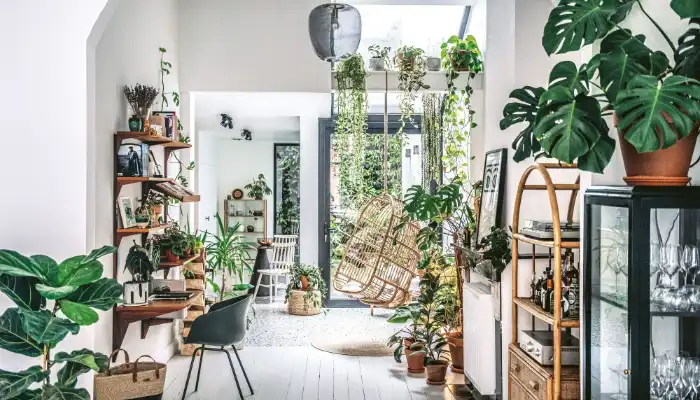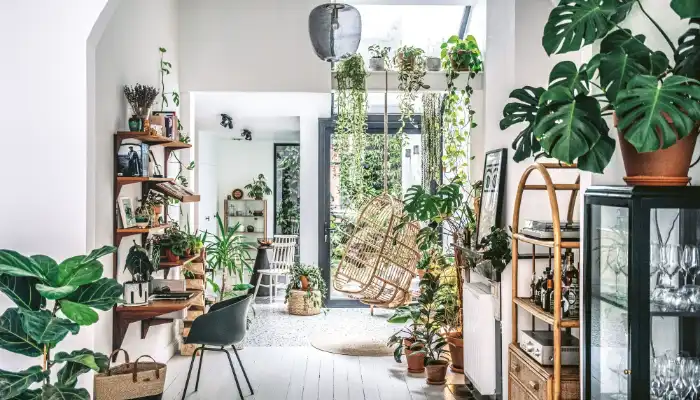
Houseplants have grown from being merely a decorative craze to becoming a choice of lifestyle. Ranging from abundant living walls to unadorned monsteras, these green companions are now decorating homes of all kinds, making our everyday spaces more alive and vibrant. However, houseplants have benefits that go beyond aesthetics. Some research findings indicate that they can filter pollutants and hence improve air quality; decrease stress levels; and even enhance creativity.
So, if you want to be part of the thriving community of houseplant enthusiasts, this comprehensive guide will give you all the tools needed to pick, situate, and nurture your green allies.

Selecting the Perfect Plant Partners: Matching Needs with Your Space
To have an indoor jungle that thrives begins with choosing the right houseplant. Here are some things to consider when selecting one:
- Light It Up: Not all plants are equal in terms of light! Bright indirect sunlight is best for many indoor plants but others can cope with lower light conditions or even deal with a bit of early morning direct sun. Determine the lighting situations in different parts of your home before you shop for a plant. South-facing windows receive the most light while north-facing ones get the least.
- Low-Maintenance Marvels: Starting? Try beginner-friendly, low-maintenance plants like snake plants, spider plants, or pothos vines instead. Tolerant beauties such as these require minimal fuss meaning that they suit busy lifestyles well.
- Aesthetic Appeal: Finally let your personal preferences guide you! From trailing philodendrons to architectural cacti, there is always a houseplant for every décor style.
Remember: Dare yourself! Mixing and matching different foliage textures adds colors and makes interesting visuals.
Finding the Perfect Spot: Arranging Your Indoor Oasis
The position of each indoor plant can make all the difference in their health and look overall. Below are some ways you can incorporate greenery into your living area in creative ways:
- Play with Scale: Use plants that vary in size and shape for added interest. Put small ones on shelves or windowsills to create an impression of a larger forest, while taller ones act as focus points or standalone pieces in the corners.
- Spreading the Green Love: Houseplants are not just for living rooms! Bathroom shelves are great for ferns due to their moist environments whereas spider plants will thrive at a well-lit kitchen window. Don’t be limited! A small succulent on your office desk can bring nature closer to you.
- Focal Point Power: Want something dramatic? Buy a big leafy plant like fiddle leaf fig or monstera that can turn any room into a jungle instantly. Place it anywhere visible such as an empty corner or near a fireplace and easily increase the aesthetic appeal of your space.
Pro Tip: Some rooms have more humidity than others so consider this when choosing your plants. Bathrooms tend to be more humid, while living rooms can be quite dry, especially during winter.
Choosing the Right Pot: A Stylish Home for Your Plant
No matter how fancy the plant may appear, without a suitable container, all is in vain. Before making your decision concerning where you are going to place it; keep these things in mind:
- Drainage is Key: For healthy plant growth, adequate drainage is a must. Pots that contain drainage holes should be purchased to avoid water logging that results in root rot. You can use saucers for this purpose but you should regularly empty them to minimize breeding of mosquitoes in your compound.
- Material Matters: Different materials have different characteristics which make pots ideal for use in different ways. There are classic ceramic pots which are available in various styles or lightweight and cheap plastic pots. Alternatively, there are terracotta pots that allow for better breathability or glass, metal, or even woven baskets which offer unique planter options.
- DIY Delight: Got creative juices flowing? You can upcycle old containers such as tea cups, tins, and even vintage suitcases into interesting and trendy-looking plant pots. Ensure you drill any necessary drain holes though.
Remember: The size of your pot should correspond with the size of the plant being put there. A large pot will result in over watering while a small one will restrict root development.
Keeping Your Plant Pals Thriving: Essential Care Tips
Now that you have chosen the perfect plants and put them in their stylish homes, learn how they can stay happy and healthy:
- Watering Wisdom: Overwatering is one of the biggest mistakes people make with houseplants. Create a watering schedule based on each plant’s specific needs including light conditions, temperature variations, and type of plant involved. In general, it’s a good idea to wait until the first inch of soil dries out before watering plants. Moisture is best determined by using the finger-in-the-soil test method: push an index finger into the dirt so you know just how wet it feels inside each day; if there isn’t enough moisture then remove some excess water from its container while adding more when needed instead of over saturating roots Killing off useful bacteria cause under-watered plants to wilt or have dried out leaves while over-watering causes yellow leaves and mushy stems.
- Pruning for Perfection: Regularly trimming your indoor plants will preserve their health and shape. Pruning creates more dense foliage, gets rid of brown shriveled or diseased leaves, and can help regulate plant size. Always check the specific pruning needs for each type of plant before you begin trimming.
- Pest Patrol: Houseplants are prone to such pests like mealy bugs, spider mites, or aphids. Check your plants regularly to find out if they are infested with sticky sap, webs, or tiny insects. Natural remedies such as neem oil spray or insecticidal soap can be used in case of minor infestations. In case of serious infestation isolate the affected plant and seek advice from a nursery professional on stronger treatments.
Bonus Tip: Sometimes houseplants need to be misted, especially during dry winter months when they’re placed near heating vents because it increases humidity around the leaves.
Styling with Plants: Bringing the Outdoors In with Finesse
Your plants finally call their new homes home; now reveal that interior designer inside you! Here are some ways in which you can integrate houseplants into your existing decor:
- Mix and Match Magic: Varying leaf textures and sizes by mixing different types of plants together gives a dramatic effect. For instance, bold monstera deliciosa would look well alongside a trailing string of pearls making those two incompatible. Additionally, put several foliage shades to match a single color scheme in a greenish color.
- Decorative Duos: If you fear to use your greenery alone, then bring in some other ornaments. A small succulent nestling inside an antique ceramic bowl or a quirky terrarium displaying an air plant is ideal for this.
- Theming It Up: The kind of decor that you already have will guide your selection of plants. For instance, if you are aiming for a minimalistic look, choose Snake Plants or ZZ Plants with clean lines and simple silhouettes. Bohemian vibes may demand hanging trailing vines like pothos or philodendrons from woven baskets or macrame hangers. In addition to this, the modern touch can be added to interiors by planting architectural plants such as cacti or air plants in geometric planters.
Beyond Beauty: Functional Houseplants for Everyday Living
Houseplants go beyond beauty since they have practical applications within homes:
- Kitchen Companions: Spice up your kitchen décor with edible herbs like basil, rosemary, and mint. They not only make the room beautiful but are also convenient sources of fresh flavor for food preparation.
- Natural Air Fresheners: For example, aromatic plants like lavender, peace lily, and lemon balm bring the smell of the outdoors into our indoor spaces. Neutralizing mal odors and creating a soothing environment can also be achieved by these sweet-smelling types.
- Privacy Please: Use houseplants as natural dividers or privacy screens in open-plan living spaces. Other large plants include ficus trees, and strategically placed hanging planters which help define different areas within one big room.
Pro Tip:
Before acquiring any edible or air-purifying plant species check their specific light and humidity requirements.
Sustainable Sanctuary: Eco-Friendly Practices for Plant Parents
Consider incorporating eco-friendly practices as you develop your urban jungle lifestyle:
- Think Local: Choose native or locally sourced varieties of plants thereby reducing the carbon footprint associated with shipping them across long distances.
- Repurpose and Replant: Give old containers a new lease on life! Make up-to-date-looking plant pots from vintage finds, glass jars, or even woven baskets.
- Water Wisely: For example, this can be achieved by watering plants using a can instead of a hose pipe, grouping plants with similar water requirements, and harvesting rainwater for irrigation purposes.
Making sustainable choices ensures that your indoor oasis is good for you as well as the planet.
Conclusion
Houseplants have numerous benefits including filtering air and improving mood and creativity. With careful planning and nurturing, one can easily develop an indoor jungle that will not only make their home aesthetically appealing but also connect them to nature. Thus feel free to experiment with your style because Houseplants could be some of the best elements to give a stunning look within your world each day outside.
